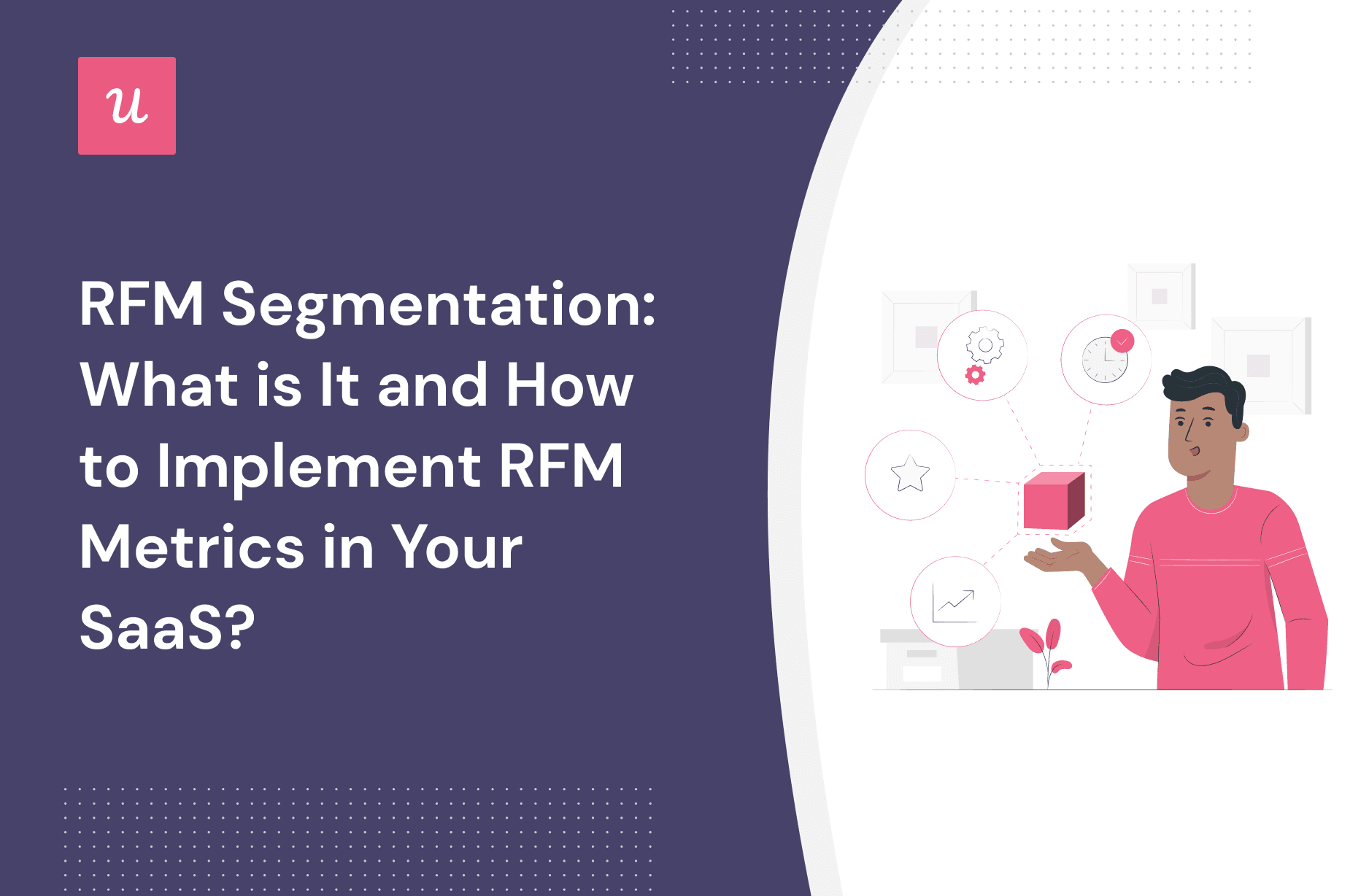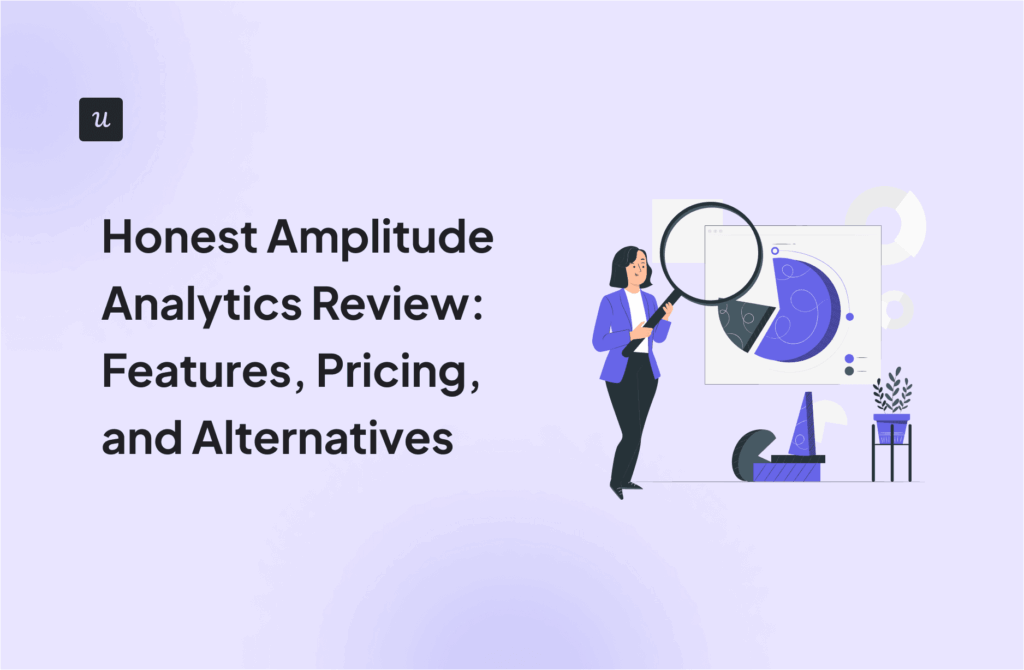
RFM Segmentation: What is It and How to Implement RFM Metrics in Your SaaS?
Curious about how to turn RFM segmentation into a powerful marketing technique for understanding customer behavior and driving growth? You came to the right place!
In this article, we’ll explain what RFM segmentation is and how you can use it to improve your SaaS business results. We also added RFM segmentation examples.
Let’s get into the nitty-gritty right away.
Get The Insights!
The fastest way to learn about Product Growth, Management & Trends.
What is the RFM model?
RFM stands for Recency, Frequency, and Monetary. It’s a three-dimensional customer segmentation model that evaluates customers on three metrics — recency, frequency, and monetary value.
Using this data, you can tailor your marketing activities to each customer segment.

What are recency, frequency, and monetary in SaaS?
Recency is the amount of time since a user last engaged with your product or service. You can get this metric by tracking product usage. It’s also about how recently customers purchased a product or subscribed to a service after a set of interactions.
This is important to know since recent customers are more engaged and are likely to be more receptive to marketing activities and upgrades in the future if onboarding goes smoothly.
Frequency is how often a customer interacts with the platform. This could include login frequency or how often they’re using features.
The frequency of a customer’s transactions may be affected by factors such as the type of product and the price point for the purchase. In SaaS, subscription renewals are more affected by product quality, product usage, and exemplary customer experience.
In short, more usage equals more upgrades and higher LTV (customer lifetime value).
Finally, the monetary value metric evaluates the amount of money that a customer has spent on a platform. It’s essential to understand which customers are spending more, as this can help you target them with higher-value products and services.
Likewise, you can track freemium users’ time spent in the app to understand which users should be upgraded to a higher-tier subscription plan. Then, you can target them with specific in-app offers.
What are the benefits of RFM segmentation?
RFM segmentation is a powerful tool that can help you increase customer retention, identify high-value customers, and drive more revenue. How is that?
Personalized messaging
With RFM messaging, you get to identify your most valuable customers (segments) and use that information in your marketing messages to attract the right audience. You can also act on this data to target existing users to increase their frequency and/or monetary value.
Improved customer experience
By understanding customer segments, you can uncover the most important needs and preferences of each segment. This lets you cater your services to their individual needs and provide a better customer experience.
Increased revenue
So how the RFM model can impact your revenue growth?
RFM analysis gives you insights into your customers’ purchase history, so you can pinpoint high-value customers and those who are likely to switch to higher plans. Target the latter customer group with personalized campaigns to prompt them to make additional purchases or upgrade their subscriptions.
RFM segmentation vs. traditional customer segmentation
RFM segmentation uses only R, F, and M variables of customer data and concentrates on purchase data. It segments users based on how often they use your product, what subscription they use and their LTV.
Traditional customer segmentation, on the other hand, collects more data and looks at factors like demographics, geographic location, psychographics, and interests. It’s much broader and can be used to create more detailed customer profiles.
How do you segment existing customers using RFM?
Now let’s get into practice and learn how to segment your customer database with RFM analysis.
Step 1: Assign RFM metrics to each customer
Get the raw data from the CRM system and group the customers into segments based on each of the three variables. Assign RFM metrics to each customer based on subscription renewal dates.
Step 2: Calculate RFM metrics
The next step is to calculate an RFM score. To do so, you need to calculate each RFM constituent separately.
How is recency calculated?
- Choose the most recent transaction date for each customer and assign a value based on how recently they purchased. The more recent the purchase, the higher the score. It usually scores between 1 and 5, depending on how many intervals are used.
- Count the number of days between today and the subscription renewal (in SaaS, plans are mostly monthly unless you have a pay-per-user subscription).
- Group customers into recency segments, such as “recent,” “medium,” and “old.”
Recency segments can differ from industry to industry, but generally, recent customers are assigned a score of 1–5, medium customers 6–10, and old customers 11+.
How is the frequency score calculated?
Frequency is an interlinked factor with pricing plans, billing models, and customer satisfaction that affects revenue. For SaaS, it’s mainly your retention rate and churn rate that determine the frequency score.
Group customers into frequency segments, such as “regular,” “medium,” and “low.”
A regular customer scores 1–5, a medium customer 6–10, and a low-frequency customer 11+.
How is the monetary value calculated?
The monetary value translates directly into revenue (CLV) and can provide valuable insights into the effectiveness of different campaigns. This RFM segment is vital for SaaS.
The monetary value is the total amount spent on subscription services over a given time period. It’s calculated by taking into account the number of subscription plans, their duration, and the total amount spent on each.
Group customers into three segments based on their monetary value: “high,” “medium,” and “low.” A high-value customer scores 1–5, a medium-value customer 6–10, and a low-value customer 11+.
Step 3: Group customers based on their score
Once you have decided on your RFM metrics and assigned them to customers (from 1-5), it’s time to categorize your customers under segments (R+F+M).
This allows you to create detailed customer profiles that provide a much better understanding of customer behavior.
- Loyal customers tend to have higher scores for all three variables and are more likely to be repeat buyers. They spend good money with you and are a good source to ask for reviews. You can also use this information to reward loyal customers with special promotions or discounts since they are a great fit for upsells and cross-selling.
- Valuable customers are new customers who have the potential to upgrade to premium subscriptions, according to historical data of typical use cases. You can use this customer data to target new users with tailored offers.
- High-value customers or Highest paying customers are the ones who use the highest subscription and have been with you for quite some time.
- Churned customers or inactive users may be potential valuable customers who have stopped using your product. They are worth trying to reengage.
Step 4: Perform RFM analysis
Produce targeted direct marketing campaigns tailored to specific customer types. For example, customers with high revenue and frequency scores would require different campaigns than those with low scores.
As such, low-frequency medium-monetary customers might be targeted with discounts or special offers to encourage them to purchase more regularly, while high-frequency low-monetary customers might be offered a greater variety of products.
How to track recency, frequency, and monetary values in SaaS products
Product marketers turn to several methods to track and collect customer data for RFM analysis — through retention and product usage analyses. But how exactly?
Track recency with retention analysis
Retention analysis looks at how recently a user has interacted with your product or service in order to gauge their level of engagement. With that, you can track recency and understand how many customers are coming back to your product/service in a given timeframe (e.g., one day, one month, etc.).
You can also pinpoint potential churn and retention patterns to drive product growth.
Track frequency with product usage data
Capture feature usage data to understand engagement. Meaning how often users use the features they need to complete their goals. How?
Here’s where Userpilot’s feature tagging comes into play. This tool records user interactions with predefined features and collects other data points of each user, such as firmographics, subscription plans, and more, for segmenting customers.

Once Userpilot collects some data, it builds the page activity report and highlights the unique and total number of views by users and companies over time. With that, product marketers understand product stickiness and usage frequency among different segments.

Track monetary value with CLV
LTV provides insights into your company’s profitability, assists with revenue forecasts, and allows you to identify and target your best customers.
Userpilot’s advanced segmentation feature lets you segment customers based on their user behavior or use case or NPS scores. This way, you can better understand customer value and send marketing messages contextually.

You can also onboard and engage mobile app users by creating personalized messaging, push notifications, and surveys.
Examples of RFM segmentation
RFM analysis translates into predicting future customer behavior, designing outstanding marketing strategies, and improving overall customer satisfaction and retention. Here is what you can do to achieve this.
Active customers based on the frequency
Customers’ activity signals how customers like your product and whether you attract your ideal customers. Apply this knowledge to optimize customer experience with timely and relevant messages.
Use product usage data to segment your active customers and target specific clusters with in-app marketing campaigns to propel users to try premium features.

Power users’ behavior based on the frequency and monetary values
Look for customers who have a high lifetime value. These customers are essential for your business, and it’s important to focus on offering them the best experience possible.
You can use customer segmentation to identify power users, establish better relationships with them, and provide them with special offers, valuable resources, and loyalty programs.

Loyal customers based on the monetary value
One more way to put RFM analysis into action is to segment customers based on their LTV and then overlay this segment with high NPS scores. As such, you’ll find loyal customers with a high monetary value.
Another method to find loyal customers is to look back at their customer transactions (money spent over time) and tie back this data to the time spent with your product. The latter you can measure in days or action items like the number of web sessions is greater than 1,000.
So you know your loyal customers, what to do next?
You can now reach out to them with an in-app modal or direct mail and invite to in-person customer development interviews or ask them to leave feedback about your product or write case studies.

Conclusion
RFM analysis is an effective way to track customer behavior and develop targeted marketing campaigns. By utilizing recency, frequency, and monetary values, you can identify customer segments that have different needs and expectations. With this data in mind, you can create personalized campaigns aimed at different customer types and maximize customer satisfaction.
Want to improve your marketing efforts and grow your business? Start with RFM analysis and book your personal demo with Userpilot to learn how to use its tools for RFM segmentation.





